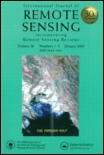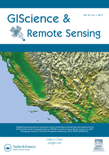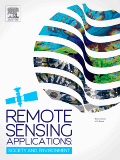
Remote Sensing Letters
Scope & Guideline
Illuminating Earth and Space Through Innovative Technologies
Introduction
Aims and Scopes
- Remote Sensing Data Acquisition and Analysis:
The journal emphasizes methodologies for acquiring and analyzing remote sensing data, including satellite, aerial, and UAV platforms. It covers topics such as data preprocessing, calibration, and the development of algorithms for extracting meaningful information from raw data. - Application in Environmental Monitoring:
Research articles often focus on the application of remote sensing technologies for monitoring environmental changes, such as land use/land cover change, climate impacts, and natural disasters. The journal highlights studies that demonstrate how remote sensing can inform management practices and policy decisions. - Integration of Advanced Technologies:
The integration of machine learning, artificial intelligence, and deep learning techniques in remote sensing applications is a core area of focus. The journal publishes works that explore innovative approaches to enhance classification, detection, and prediction capabilities using these technologies. - Interdisciplinary Approaches:
Remote Sensing Letters encourages interdisciplinary research that combines remote sensing with other scientific fields such as hydrology, agriculture, forestry, and urban studies. This approach fosters a comprehensive understanding of complex environmental issues. - Emerging Remote Sensing Techniques:
The journal is at the forefront of publishing studies on new and emerging remote sensing technologies, including hyperspectral imaging, synthetic aperture radar (SAR), and LiDAR. It highlights innovations that improve the precision and applicability of remote sensing data.
Trending and Emerging
- Machine Learning and Deep Learning Applications:
There is a significant increase in research utilizing machine learning and deep learning techniques for various remote sensing applications, such as image classification, change detection, and anomaly detection. These approaches leverage large datasets to enhance accuracy and efficiency. - Big Data and Cloud Computing in Remote Sensing:
The integration of big data analytics and cloud computing technologies is emerging as a key theme. Researchers are exploring ways to manage and process vast amounts of remote sensing data more effectively, enabling real-time analysis and decision-making. - Climate Change and Environmental Impact Studies:
Research focusing on climate change and its impacts through remote sensing is gaining prominence. This includes studies on land surface temperature, vegetation response, and hydrological changes, reflecting the urgent need for monitoring environmental shifts. - Fusion of Multi-Source Data:
The trend of fusing data from multiple sources, such as optical, SAR, and LiDAR, is increasingly evident. This approach allows for more comprehensive analyses and improved accuracy in applications such as urban planning and disaster management. - Automated and Real-Time Monitoring Systems:
Emerging themes also include the development of automated monitoring systems for environmental changes, utilizing remote sensing technologies to enable real-time data acquisition and analysis. This trend is particularly relevant in disaster response and resource management.
Declining or Waning
- Traditional Remote Sensing Techniques:
Research focusing solely on traditional remote sensing methods, such as basic optical imagery analysis without advanced processing or integration techniques, has seen a decrease. This may be due to the growing emphasis on more sophisticated methodologies that incorporate machine learning and big data analytics. - Standalone Studies Without Interdisciplinary Context:
There has been a noticeable decline in studies that do not integrate remote sensing with other scientific disciplines. As interdisciplinary approaches become more valued, research that remains isolated from broader environmental or socio-economic contexts may be less favored. - Basic Land Cover Classification:
While land cover classification remains important, studies that employ basic methods without incorporating advanced algorithms or contextual data have diminished. The field is moving towards more complex analyses that leverage deep learning and multi-source data integration. - Field Studies with Limited Remote Sensing Integration:
Research that focuses primarily on field studies with minimal integration of remote sensing data is becoming less common. The trend is shifting towards studies that utilize remote sensing as a primary data source, complemented by ground-truthing.
Similar Journals

European Journal of Remote Sensing
Exploring New Horizons in Applied Mathematics and Remote SensingThe European Journal of Remote Sensing, published by Taylor & Francis Ltd, stands as a pivotal resource in the domains of applied mathematics, atmospheric science, and earth sciences. Since its transition to Open Access in 2012, the journal has facilitated unrestricted knowledge dissemination, fostering collaboration and innovation among researchers. With a notable impact factor reflected in its quartile rankings—achieving Q2 in applied mathematics and atmospheric science, and Q1 in miscellaneous environmental science—the journal is a respected platform for high-quality research. Based in the United Kingdom, it encompasses a wide range of topics related to remote sensing technologies and their application in environmental monitoring. Researchers and professionals in these fields will find the journal indispensable for its commitment to advancing scientific understanding and promoting the use of remote sensing methodologies in tackling contemporary environmental challenges.

Journal of Geovisualization and Spatial Analysis
Exploring the Intersection of Geography and InnovationJournal of Geovisualization and Spatial Analysis, published by SpringerNature, is an influential open-access journal specializing in the cutting-edge fields of geovisualization, spatial analysis, and their application in earth sciences and geography. Since its inception in 2017, this journal has established a prominent stance with a high impact factor and prestigious Q1 rankings across multiple categories, including Computers in Earth Sciences, Earth and Planetary Sciences (miscellaneous), and Geography, Planning and Development. The editorial board is committed to advancing innovative research and methodologies, providing a platform for scholars to disseminate their findings globally. With impressive Scopus rankings—placing it in the top percentiles among its peers—the journal serves as a vital resource for researchers, professionals, and students keen on understanding spatial data and its implications for geographic science. Its emphasis on rigorous peer review and rapid publication enhances accessibility to substantive research, thus fostering knowledge sharing within the scientific community. Based in Switzerland, the journal promotes a collaborative environment for interdisciplinary studies, making it an essential read for anyone involved in spatial analysis research.

INTERNATIONAL JOURNAL OF REMOTE SENSING
Unveiling the Secrets of Our Planet from AboveInternational Journal of Remote Sensing, published by Taylor & Francis Ltd, stands at the forefront of Earth and Planetary Sciences, providing a critical platform for disseminating pioneering research since its inception in 1980. With an impressive ranking of #25 out of 195 in general Earth and Planetary Sciences and a notable 87th percentile on Scopus, this journal is recognized for its high-quality contributions that span diverse topics including satellite imagery analysis, geospatial technologies, and environmental monitoring. As a Q1 journal in its field for 2023, it offers invaluable insights and methodologies that are essential for researchers, professionals, and students alike. Although not Open Access, the journal facilitates a comprehensive understanding of remote sensing sciences, ensuring that the scholarly community remains updated with the latest advancements, trends, and applications that impact global challenges.

Remote Sensing in Ecology and Conservation
Pioneering open-access research to protect our planet's biodiversity.Remote Sensing in Ecology and Conservation is a pioneering journal published by WILEY that has been a beacon of open-access research since 2015. With an E-ISSN of 2056-3485, this journal stands at the forefront of the intersection between ecological research and technological innovation. It is recognized for its significant impact, boasting Q1 rankings across several prestigious categories in 2023, including Computers in Earth Sciences and Ecology, emphasizing its commitment to high-quality, influential scholarship. The journal provides a platform for researchers and practitioners to share their findings in remote sensing applications that advance ecological conservation efforts. Encompassing a broad scope that includes studies on landscape changes, biodiversity assessments, and environmental monitoring, it serves as an essential resource for education and practice in the field. With impressive ranks in Scopus, including a remarkable 6th place in Earth and Planetary Sciences, it continues to shape the dialogue in ecology and conservation. As an open-access journal, it champions the dissemination of knowledge, making critical research accessible to a global audience, thereby fostering innovation and collaboration in the pursuit of sustainable environmental practices.

Science of Remote Sensing
Transforming Data into Insight for Environmental ProgressScience of Remote Sensing, published by Elsevier, is a premier open-access journal that has been at the forefront of interdisciplinary research since its inception in 2020. With an impressive impact factor and its status in the Q1 quartile category for both Earth and Planetary Sciences and Forestry, this journal effectively caters to a diverse audience, including researchers, professionals, and students interested in the latest developments in remote sensing technologies and their application across varied domains. Located in the Netherlands, the journal provides a collaborative platform for scientific discourse, ensuring that impactful research is easily accessible to the global community. As it converges its focus through to 2024, Science of Remote Sensing continues to promote innovation and excellence, establishing itself as a vital resource for advancing knowledge in both the agricultural and environmental sectors. With a robust ranking (Rank #6 in Forestry and Rank #8 in General Earth and Planetary Sciences), it is well-positioned to contribute significantly to ongoing scientific advancements.

Remote Sensing
Unlocking the Secrets of Our Planet with Cutting-Edge ResearchRemote Sensing is a highly esteemed journal published by MDPI, dedicated to the domain of Earth and Planetary Sciences. With an impressive impact factor reflected in its rank of #16 out of 195 in the general Earth and Planetary Sciences category, this journal achieves a commendable 92nd percentile among its peers, indicating its significant contribution to the field. Since its inception in 2009 as an Open Access journal, it has enabled researchers, professionals, and students from around the globe to access high-quality, peer-reviewed articles that delve into the latest advancements in remote sensing technologies, methodologies, and applications. Based in Switzerland, Remote Sensing serves as a vital platform for disseminating innovative research that supports and enhances our understanding of Earth's processes and environments, ensuring scientific knowledge remains freely accessible and impactful.

ISPRS International Journal of Geo-Information
Transforming spatial data into actionable insights.ISPRS International Journal of Geo-Information, published by MDPI, stands at the forefront of the field of geospatial sciences, contributing valuable knowledge and research insights since its inception in 2012. This open access journal, which boasts an impressive collection of articles that emphasize the integration of geographic information systems (GIS) in Earth and planetary sciences, currently achieves a remarkable standing, with a 2023 impact factor ranking in the Q1 category for both Earth and Planetary Sciences and Geography, Planning and Development. Researchers and professionals engaged in the study of spatial data, remote sensing, and innovative geoinformation technologies will find the journal an essential resource, offering diverse perspectives and methodologies. With its open access model, the journal aims to promote the dissemination of knowledge globally, fostering collaboration among scholars while pushing the boundaries of research in geoinformation disciplines. The journal is based in Switzerland and is well-positioned to contribute significantly to the understanding and application of geospatial data for societal advancements.

CANADIAN JOURNAL OF REMOTE SENSING
Innovating Insights Through Satellite ImageryCanadian Journal of Remote Sensing is a prestigious, peer-reviewed journal published by Taylor & Francis Inc., based in the United Kingdom. With an impressive impact factor and a Scopus ranking placing it in the 76th percentile among general Earth and Planetary Sciences, this journal is integral for researchers and professionals exploring the dynamic field of remote sensing. Since its inception in 1975 and now continuing through to 2024, it has been a platform for disseminating cutting-edge research and advancements in both methodologies and applications across diverse environments. As of 2023, it has transitioned to Open Access, ensuring wider access to its scholarly articles, which cover a broad spectrum of topics including satellite imagery, data interpretation, and environmental monitoring. This journal is not only crucial for fostering innovation and collaboration within Earth sciences but also serves as a critical resource for students and academics alike, eager to stay abreast of the latest developments in remote sensing technology and methodology.

GIScience & Remote Sensing
Elevating Research in Remote Sensing and GIScienceGIScience & Remote Sensing, published by Taylor & Francis Ltd, stands as a leading journal in the realm of Earth and Planetary Sciences, holding a prestigious Q1 ranking. Since its transition to Open Access in 2022, the journal has significantly broadened its reach, enabling researchers, professionals, and students across the globe to disseminate and access cutting-edge research related to geographic information science and remote sensing technologies. With a focus on publishing high-quality, peer-reviewed articles that contribute to the understanding of the Earth’s processes, environments, and interactions, this journal not only supports advancements in scientific knowledge but also fosters interdisciplinary collaboration. Based in the United Kingdom, GIScience & Remote Sensing continues to pave the way for innovative methodologies and applications, solidifying its vital role within the scientific community.

Remote Sensing Applications-Society and Environment
Exploring innovative solutions through the lens of remote sensing.Remote Sensing Applications-Society and Environment, published by Elsevier, stands at the forefront of interdisciplinary research, bridging the fields of remote sensing and environmental science. With an impressive impact factor and recognition within the Q1 quartile in both Computers in Earth Sciences and Geography, Planning and Development, the journal is a vital resource for researchers, professionals, and students committed to advancing our understanding of environmental dynamics through innovative remote sensing technologies. Since its inception in 2015, this journal has cultivated a rich repository of knowledge, addressing pertinent societal and environmental issues, making it a leading source for transformative applications in the field. Accessible and relevant, articles published here not only explore theoretical advancements but also practical implications, ensuring research findings are effectively disseminated to stimulate further inquiries and applications in sustainability and ecological stewardship. The journal's strong Scopus rankings, particularly within its categories, solidify its role as an essential platform for scholarly exchange.